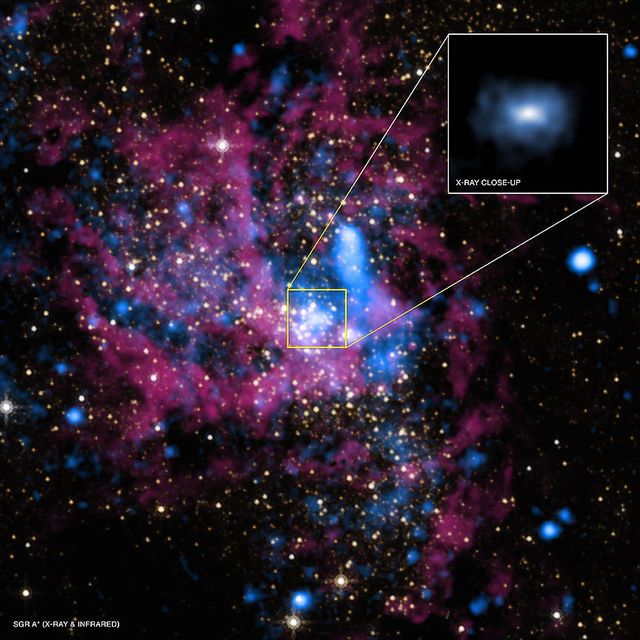- There's a supermassive black hole at the center of our galaxy. According to scientists who have been studying it for years, it has suddenly expanded.
- Nobody's sure what has caused the expansion, but scientists have theories concerning stars and asteroids close to the black hole.
- Earth is not in any danger from the expansion, astronomers say.
It's easy to forget, so as a reminder: There's a supermassive black hole at the center of the Milky Way, Earth's galaxy. That's not so odd on its own, as astronomers believe supermassive black holes reside at the center of nearly every galaxy. But something's happening with the Milky Way's black hole, also known as Sagittarius A* or Sgr A*, that's unexpected: It's getting hungrier.
"We have never seen anything like this in the 24 years we have studied the supermassive black hole," says Andrea Ghez, UCLA professor of physics and astronomy and a co-senior author of the latest research, in a press statement. "It's usually a pretty quiet, wimpy black hole on a diet. We don't know what is driving this big feast."
Ghez and her team have been studying Sagittarius A* for years. They came to their conclusion after analyzing over 13,000 observations of the black hole from 133 nights beginning in 2003. The photos came from two of the world's elite observatories, with some taken from the W.M. Keck Observatory in Hawaii and others gathered from the European Southern Observatory's Very Large Telescope in Chile.
Looking at the observations recently, they noticed that on May 13, the area close to the black hole's infamous "point of no return"—where the gravitational pull is so strong that no matter, even light, can escape—was "twice as bright as the next-brightest observation."
Combined with two other size changes in 2019, Ghez says that seeing a Sagittarius A* fluctuate like this in such a short time frame is "unprecedented."
On one level, scientists know what is causing the brightness. It's the same type of brightness that typically occurs in this region, stemming from gas and dust radiation falling into the black hole. But the expansion of that phenomenon is still a mystery. Was this a one-time growth spurt, something that will continue, or just a one-off oddity that will relapse?
"The big question is whether the black hole is entering a new phase—for example if the spigot has been turned up and the rate of gas falling down the black hole 'drain' has increased for an extended period—or whether we have just seen the fireworks from a few unusual blobs of gas falling in," says Mark Morris, UCLA professor of physics and astronomy and the paper's co-senior author.
One idea the scientists have considered: looking to the black hole's neighbors. Sgr A* has many orbiting stars and gas clouds. One of these stars is known as S0-2, which is around 10 to 15 times the size of Earth's sun and orbits the black hole like planets do within our solar system. During the summer of 2018, it sent out a large amount of gas that reached the black hole this year.
"The first image I saw that night, the black hole was so bright I initially mistook it for the star S0-2, because I had never seen Sagittarius A* that bright," says UCLA research scientist Tuan Do, the study's lead author. "But it quickly became clear the source had to be the black hole, which was really exciting."
There's also a theory concerning the space oddity G2, which scientists believe is likely a pair of binary stars. G2 approached the black hole in 2014, and Sgr A* might have stripped off the outer layer of G2 and scientists are just seeing it now. And then there's a third theory, which looks at the timing of the demise of large asteroids that have gotten pulled into its gravitational reach.
The team's findings have been published in Astrophysical Journal Letters, the latest in a year of discovery for black holes. Back in April, scientists were able to finally ascertain physical proof of their existence in a new, historic photo.
David Grossman is a staff writer for PopularMechanics.com. He's previously written for The Verge, Rolling Stone, The New Republic and several other publications. He's based out of Brooklyn.














